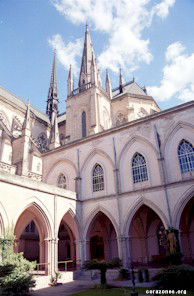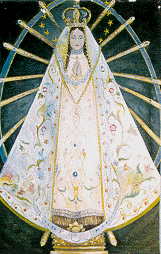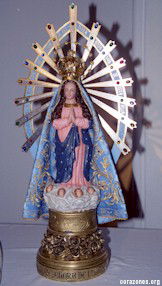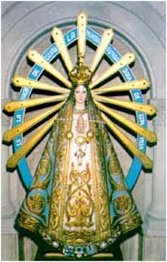Our Lady of Luján Patroness of Argentina

The small image of baked clay (terracotta) barely measures 38 centimeters but it is immense because it represents the Mother of God. It has an air of resemblance to the works of Murillo. It is a representation of the Immaculate Conception modeled in Brazil and sent to Argentina in May 1630. The primitive chapel was in the house of Don Rosendo. A bigger and more beautiful sanctuary was finished in 1685 and the present temple was built in the XIX century. In 1887 the image was covered with a solid silver frame in order to stop its deterioration. She wears a beautiful white tunic and a light blue mantle (colors of the Argentinean flag). The Virgin is dark, with an oval face and blue eyes. She has her hands in prayer next to her chest.
How the Virgin arrived at LujánAntonio Farías Sáa, a landowner living in Sumampa (Santiago del Estero) wanted to place a chapel for the Virgin in his ranch. He asked a friend who lived in Brazil to send him an image representing the Immaculate Conception of Mary. The friend sent him two, the one he had commissioned and another of the Virgin and Child Jesus. When they arrived, they were placed in a cart and left in a caravan for Sumampa. The image was being carried by cart from Buenos Aires to Santiago del Estero when it inexplicably stopped on the banks of the Luján River (67 km from Buenos Aires), near the house of Don Rosendo Oramas. The oxen were changed and the load was lowered, but to no avail. The oxen refused to cross the river. Then someone noticed the two small boxes with the images of the Virgin. They lowered the statue of the Virgin and Child without anything happening, but when they removed the box with the Immaculate Conception, the oxen immediately started to move. The astonished witnesses repeated this again and again, with identical results. Thus they understood that Our Lady wanted to stay in Lujan and they gladly and joyfully obliged. Soon the news spread and numerous pilgrims arrived. At first the image was taken to the house of Don Rosendo, who built the original chapel where Our Lady was venerated for forty years.
A slave chosen by Our Lady: ManuelManuel was brought from Africa and sold as a slave in Brazil. He arrived in the Rio de la Plata when he was 25 years old, in the same boat where the blessed image of the Virgin was brought. He witnessed the miracle at Don Rosendo's ranch and since then he dedicated his life to take care of the Virgin of Lujan.
Tradition tells us that Manuel received the gift of healing with the tallow from the candles in the chapel and told pilgrims about the travels of the Holy Virgin, who came out at night to comfort the afflicted. Over the years, don Rosendo passed away and the place was almost abandoned, but this man was always faithful and continued to serve the Virgin.
Doña Ana de MatosWidow of Siqueyras, Doña Matos had land next to the Luján River, and wanted to build a chapel and take the image to her house. In 1671 she spoke with Father Juan de Oramas, administrator of the property of Don Rosendo and placed it in her house, but the Holy Virgin disappeared and was found in her old chapel. Doña Ana took the image back to her house and for the second time it returned to Don Rosendo's ranch. Doña Ana then consulted the ecclesiastical and civil authorities, who traveled to the place and examined what had happened, this time the Virgin was taken in a devout pilgrimage and accompanied by Manuel. From that moment on, the image never returned to its former chapel. After confirming the veracity of what had happened, the ecclesiastical authority officially authorized the public worship of the "Pure and Clean Conception of the Lujan River". Doña Ana donated the land for the construction of the new temple in 1677, where the beautiful Basilica of Luján is currently located.
CONTINUATION OF "BASILICA OF LUJAN
"The miracle of Father Pedro de Montalbo.
Father Montalbo was hopeless when in 1684 he traveled to Luján. Almost dying, he was taken to the chapel. Black Manuel anointed his chest with tallow from the lamp burning on the altar and gave him to drink an infusion with thistles that he used to take from the Virgin's dress. Don Pedro miraculously healed and gratefully remained as the first chaplain.
The Town of Luján
The place began to be populated with the devotees of the Virgin and took the name of Nuestra Señora de Luján. In 1755 it was granted the title of Villa. Devotion and miracles increased and on October 23, 1730, Luján was established as a parish. The parish priest Don José de Andújar wanted to enlarge the temple and together with Bishop Fray Juan de Arregui, started the construction, but it ended up collapsing before being inaugurated.
Don Juan de Lezica y Torrezuri
Born in Vizcaya, Spain, Don Juan was very ill when he was miraculously cured by the Blessed Virgin of Luján. In gratitude he gave himself completely to the creation of the new temple and in August 1754 the construction began. In 1765 the work was happily completed and the town councilors of Luján elected and swore to Our Lady as their heavenly Queen and Patroness.
Origins of the National Basilica of Luján
Around the year 1872, the Archbishop of Buenos Aires, Monsignor Federico Aneiros, gave the custody of the temple to the priests of the Congregation of the Mission, known as Lazarist Fathers (founded by St. Vincent de Paul). At that time, Father Jorge María Salvaire was wounded on a trip by the Indians and was on the verge of death. At that time he made a promise to the Blessed Virgin and was miraculously healed. Father Salvaire's promise was, "I will publish your miracles..., I will magnify your Church". In fulfillment of this vow, he published in 1885 the "History of Our Lady of Lujan".
In 1889 he was appointed Pastor of Luján and dedicated his life and efforts to build the great Basilica, with the support of Monsignor Aneiros and the collaboration of his companions of the Congregation, he began the construction of the current National Basilica on May 6, 1890. The Basilica was inaugurated in 1935. The director of the work was the engineer Ulrico Courtois. The grandiose basilica, in Gothic style, has beautiful stained glass windows. The crypt of the basilica houses many treasures related to the history of Luján, it also has beautiful replicas of all the Marian advocations of America.
Ecclesiastical Approval: The Solemn Coronation of the Virgin of Luján
Father Salvaire, in 1886, presented to Pope Leo XIII, the request of the Episcopate and the faithful of the Rio de la Plata for the coronation of the Virgin. The Pontiff blessed the crown and granted her proper Office and Mass for her feast, which was established on the Saturday before the IV Sunday after Easter. The canonical coronation took place on May 8, 1887. The sanctuary received from Pius XII the title of Basilica in 1930.
John Paul II blessed the image of Our Lady of Luján on November 11, 1995, on the occasion of the "ad limina" visit of the Argentinean bishops.
On November 13, 1998, the Pope visited the national church of Argentina in Rome, the first temple of an American republic located in the Pope's diocese, and enthroned the image of Our Lady of Lujan, patroness of Argentina.
The Pope said: "At the crossroads of the Third Millennium I entrust to you, Holy Mother of Luján, the Argentinean homeland: the hopes and desires of its people; its families and homes, so that they may live in holiness; its children and youth, so that they may grow in peace and harmony and may find their human and Christian vocation; I also entrust to you the daily efforts and dialogue in solidarity of businessmen, workers and politicians, who find their most genuine inspiration in the Social Doctrine of the Church".
The pontiff also prayed to the Virgin Patroness of Argentina to take care of the Argentine people, to support them in the defense of life, to console them in tribulation, to accompany them in joy and to help them always "to raise their gaze to heaven, where the colors of their flag are confused with the colors of your immaculate mantle".
Pope John Paul II visited Argentina twice, the first time during the Falklands War. The Pope was also a mediator for peace with Chile.




